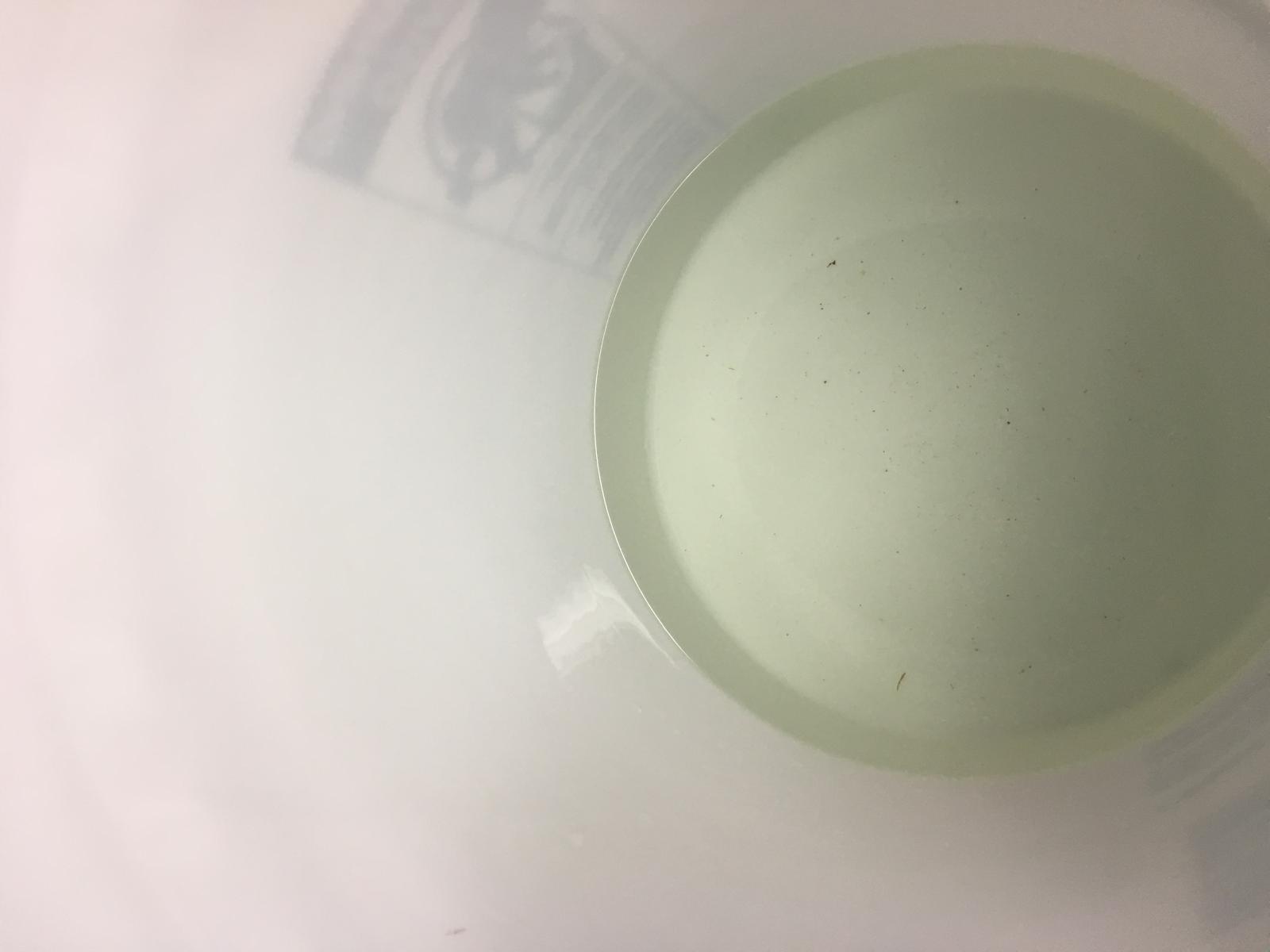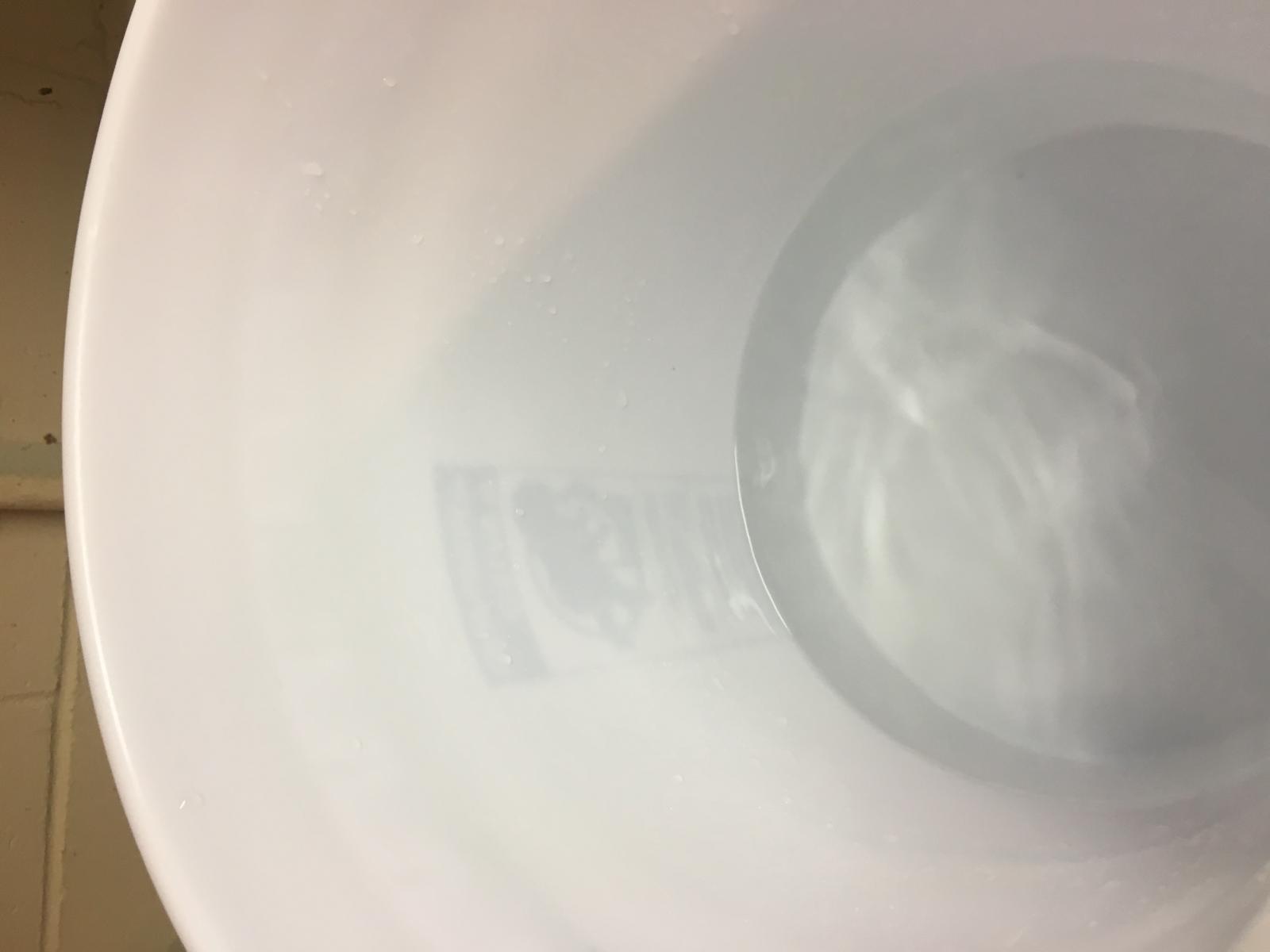You are using an out of date browser. It may not display this or other websites correctly.
You should upgrade or use an alternative browser.
You should upgrade or use an alternative browser.
Used plate chiller corrosion, clean with oxyclean?
- Thread starter Nemanach
- Start date

Help Support Homebrew Talk:
This site may earn a commission from merchant affiliate
links, including eBay, Amazon, and others.
augiedoggy
Well-Known Member
Just be careful the acid will weaken the copper brazing over time I believe.I did a little more searching and it seems acid cleaners are best. Think a cup of vinegar in a gallon of water recirculated for a while would do it?
mpmccann
Well-Known Member
I have baked my plate chiller, used OxiClean, but I am now using home made PBW which I believe is working the best for all brewery cleaning. You can find the recipe here https://www.homebrewtalk.com/showthread.php?t=467655...
I might also add, you will never get it completely clean. There will always be some junk that comes out no matter how many times or how long you recirculate cleaner through it. Just the way it is my friend. I ended up using a SS mesh strainer that hangs on the side of my BK for all hop additions and Irish moss, etc. to keep stuff out of the chiller.
Hope this helps...
I might also add, you will never get it completely clean. There will always be some junk that comes out no matter how many times or how long you recirculate cleaner through it. Just the way it is my friend. I ended up using a SS mesh strainer that hangs on the side of my BK for all hop additions and Irish moss, etc. to keep stuff out of the chiller.
Hope this helps...
It actually seems very clean. Nothing comes out when I flush it and flow is great. My only concern is hidden green copper corrosion which I understand to be poisonous. I plan on recirculating the last 15 minutes of boil through it and will be using a hop spider so it will be sterilized that way, I’m not really concerned about a little hidden hop material.
Verdigris, nasty stuff: https://toxnet.nlm.nih.gov/cgi-bin/sis/search/a?dbs+hsdb:@term+@DOCNO+258
I remember reading somewhere in the forums a while back about someone giving an initial soak in a vinegar solution, then rinsing it out, then repeat until the solution no longer turns blue/green. Though I don't understand how soaking in vinegar solution in even clean copper wouldn't in if itself cause the solution to turn green.
So how about rinsing it really well with hot vinegar solution, then rinse out even better with pbw? idk... What's copper's reaction to high pH (pbw) solutions?
http://howtobrew.com/book/appendices/appendix-b/brewing-metallurgy
https://en.wikipedia.org/wiki/Copper_toxicityAcute exposure and attendant copper toxicity is possible when cooking or storing highly acidic foods in unlined copper vessels for extended periods, or by exposing foodstuffs to reactive copper salts (copper corrosion, or verdigris). Continuous, small ("chronic") exposures of acidic foods to copper may also result in toxicity in cases where either surface area interaction potentials are significant, pH is exceptionally low and concentrated (in the case of cooking with, for example, vinegar or wine), or both, and insufficient time elapses between exposures for normal homeostatic elimination of excess copper.
I remember reading somewhere in the forums a while back about someone giving an initial soak in a vinegar solution, then rinsing it out, then repeat until the solution no longer turns blue/green. Though I don't understand how soaking in vinegar solution in even clean copper wouldn't in if itself cause the solution to turn green.
So how about rinsing it really well with hot vinegar solution, then rinse out even better with pbw? idk... What's copper's reaction to high pH (pbw) solutions?
http://howtobrew.com/book/appendices/appendix-b/brewing-metallurgy

$176.97
1pc Commercial Keg Manifold 2" Tri Clamp,Ball Lock Tapping Head,Pressure Gauge/Adjustable PRV for Kegging,Fermentation Control
hanhanbaihuoxiaoshoudian

$2.41
$29.95
Mastering Homebrew: The Complete Guide to Brewing Delicious Beer (Beer Brewing Bible, Homebrewing Book)
Clickgoodwill

$58.16
HUIZHUGS Brewing Equipment Keg Ball Lock Faucet 30cm Reinforced Silicone Hose Secondary Fermentation Homebrew Kegging Brewing Equipment
xiangshuizhenzhanglingfengshop

$53.24
1pc Hose Barb/MFL 1.5" Tri Clamp to Ball Lock Post Liquid Gas Homebrew Kegging Fermentation Parts Brewer Hardware SUS304(Gas MFL)
Guangshui Weilu You Trading Co., Ltd

$10.99 ($31.16 / Ounce)
Hornindal Kveik Yeast for Homebrewing - Mead, Cider, Wine, Beer - 10g Packet - Saccharomyces Cerevisiae - Sold by Shadowhive.com
Shadowhive

$479.00
$559.00
EdgeStar KC1000SS Craft Brew Kegerator for 1/6 Barrel and Cornelius Kegs
Amazon.com
![Craft A Brew - Safale S-04 Dry Yeast - Fermentis - English Ale Dry Yeast - For English and American Ales and Hard Apple Ciders - Ingredients for Home Brewing - Beer Making Supplies - [1 Pack]](https://m.media-amazon.com/images/I/41fVGNh6JfL._SL500_.jpg)
$6.95 ($17.38 / Ounce)
$7.47 ($18.68 / Ounce)
Craft A Brew - Safale S-04 Dry Yeast - Fermentis - English Ale Dry Yeast - For English and American Ales and Hard Apple Ciders - Ingredients for Home Brewing - Beer Making Supplies - [1 Pack]
Hobby Homebrew

$22.00 ($623.23 / Ounce)
AMZLMPKNTW Ball Lock Sample Faucet 30cm Reinforced Silicone Hose Secondary Fermentation Homebrew Kegging joyful
无为中南商贸有限公司

$53.24
1pc Hose Barb/MFL 1.5" Tri Clamp to Ball Lock Post Liquid Gas Homebrew Kegging Fermentation Parts Brewer Hardware SUS304(Liquid Hose Barb)
yunchengshiyanhuqucuichendianzishangwuyouxiangongsi

$39.22 ($39.22 / Count)
Brewer's Best Home Brew Beer Ingredient Kit - 5 Gallon (Mexican Cerveza)
Amazon.com

$7.79 ($7.79 / Count)
Craft A Brew - LalBrew Voss™ - Kveik Ale Yeast - For Craft Lagers - Ingredients for Home Brewing - Beer Making Supplies - (1 Pack)
Craft a Brew
augiedoggy
Well-Known Member
Same here but since Ive used one from the start I have had no issues with solid stuff or buildup going in or coming out of my plate chiller..(knock on wood)I ended up using a SS mesh strainer that hangs on the side of my BK for all hop additions and Irish moss, etc. to keep stuff out of the chiller.
Hope this helps...
augiedoggy
Well-Known Member
Verdigris, nasty stuff: https://toxnet.nlm.nih.gov/cgi-bin/sis/search/a?dbs+hsdb:@term+@DOCNO+258
https://en.wikipedia.org/wiki/Copper_toxicity
I remember reading somewhere in the forums a while back about someone giving an initial soak in a vinegar solution, then rinsing it out, then repeat until the solution no longer turns blue/green. Though I don't understand how soaking in vinegar solution in even clean copper wouldn't in if itself cause the solution to turn green.
So how about rinsing it really well with hot vinegar solution, then rinse out even better with pbw? idk... What's copper's reaction to high pH (pbw) solutions?
http://howtobrew.com/book/appendices/appendix-b/brewing-metallurgy
This is exactly why unlined copper pots and pans are not sold anymore and why copper is banned wine/food contact in wineries. brewing is one of the only industries left where direct contact is allowed along with cheese making I believe..
hotwatermusic
Well-Known Member
Just to be clear is the OP posting about a copper brazed plate chiller? If so and there is signs of verdigris on the outside, I would just suggest taking the loss and wasting it. Can you disassemble the plates for a proper cleaning? I had a hand-me-down immersion chiller with signs that I could never get clean and that was with access and scrubbing.
...But Bar Keeper's Friend might be another option. With a rinse immediately after.
...But Bar Keeper's Friend might be another option. With a rinse immediately after.
Duda responded to my email on the chiller. They suggested soaking in vinegar for 5 minutes, rinsing really well then flushing with lye, PBW or baking soda to neutralize. They said the vinegar needs to be flushed well or it will make the problem worse.
When I drained the vinegar it was definitely had a blue/green tint to it. I'm not sure if that means there was verdigris or if that would happen anyways with vinegar and copper. I throw a piece of hard copper pipe in vinegar for 5 minutes to test and didn't see any green but that could be because of the alloying.
Attached are pictures from the exterior of the chiller. This was after I splashed vinegar all over it so there wasn't as much. You can see a little in the corner photo.
Edit: I can't understand why the pictures are upside down. They were upside down when mine are correct on my computer, I flip them on my computer and they are still upside down.
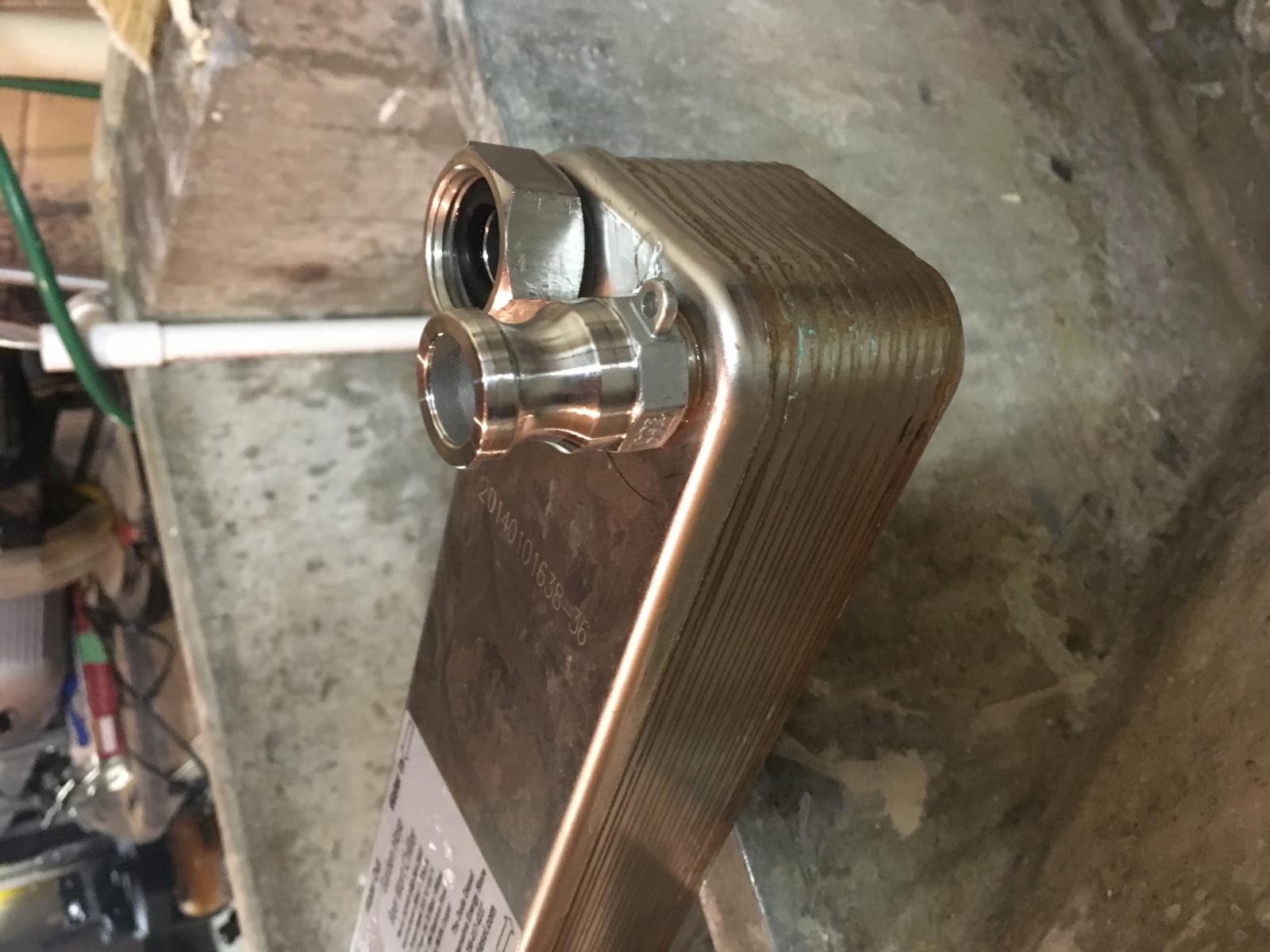
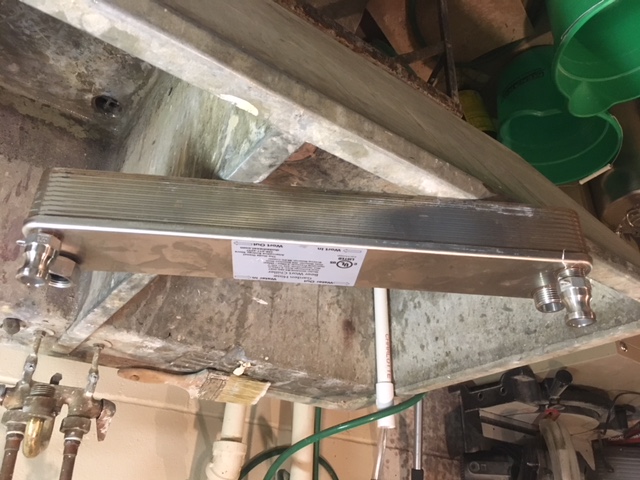
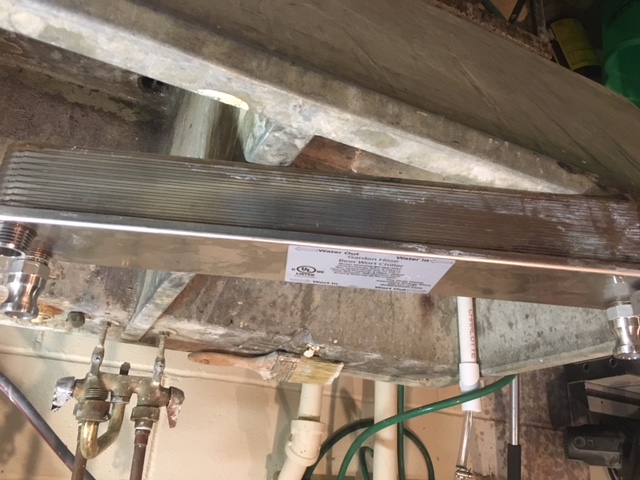
When I drained the vinegar it was definitely had a blue/green tint to it. I'm not sure if that means there was verdigris or if that would happen anyways with vinegar and copper. I throw a piece of hard copper pipe in vinegar for 5 minutes to test and didn't see any green but that could be because of the alloying.
Attached are pictures from the exterior of the chiller. This was after I splashed vinegar all over it so there wasn't as much. You can see a little in the corner photo.
Edit: I can't understand why the pictures are upside down. They were upside down when mine are correct on my computer, I flip them on my computer and they are still upside down.



This morning I acidified water to 5.1 pH which should be similar to wort. I let it sit in the chiller for 30 minutes. I dumped it into a glass jar and couldnt detect any blue coloring, the water tasted sharp but I assume that is the acidity, I dont taste copper in it. It makes me feel better but Im not sure if its a false sense of security. Maybe Im making too big of a deal about a small amount of exterior corrosion.
This morning I acidified water to 5.1 pH which should be similar to wort. I let it sit in the chiller for 30 minutes. I dumped it into a glass jar and couldnt detect any blue coloring, the water tasted sharp but I assume that is the acidity, I dont taste copper in it. It makes me feel better but Im not sure if its a false sense of security. Maybe Im making too big of a deal about a small amount of exterior corrosion.
I'd try it with the liquid boiling hot and recirculating.
Maybe recirc with starsan, I know it brightens up tarnished copper immersion chillers.
processhead
Well-Known Member
So are you assuming that since there is visible corrosion on the outside, that the inside is also corroded?
Not saying that it isn't, but I don't think you can just assume that it is either.
When I recirculate hot cleaning solution (PBW) through my copper CFC for a long time, I will sometimes get green/blue tinted coloration to the solution. This even when it is clean. I think some metallic copper will dissolve and react with strong acid or alkaline solutions under the right conditions.
Not saying that it isn't, but I don't think you can just assume that it is either.
When I recirculate hot cleaning solution (PBW) through my copper CFC for a long time, I will sometimes get green/blue tinted coloration to the solution. This even when it is clean. I think some metallic copper will dissolve and react with strong acid or alkaline solutions under the right conditions.
The outside is what brought up the concern. I put vinegar in it for 5 minutes and it came out very blue which confirmed my suspicion. I then ran 5.1 pH water through it which should be similar to wort and got light blue water in the post above. Since then I have soaked it in vinegar for 5-15 minutes each time for ~5 cycles, each time the vinegar was blue. The vinegar at the end of my cycles was certainly much better than the first time but it was still blue.
As a test I soaked it for 15 min in vinegar. I also soaked my immersion chiller in a different bucket with the same amount of vinegar. The plate chiller vinegar had a light blue tint, the immersion vinegar was clear. I wanted to see if the blue color was normal for clean copper.
As a final test I again ran 5.1 pH water through it while boiling for 15 minutes. Then circulated for another 15 min when the burner was off. I got a light blue solution. I did the same test with my immersion chiller and still got a blue solution but it was much lighter, barely noticeable as blue. So some comes off with the immersion and more comes off with the plate chiller.
The blue against the immersion chiller control has me nervous but I’m not educated enough to know how much is too much. The immersion chiller is probably an alloy which may slow the leaching of copper and it may be completely normal for the plate chiller to add more copper to the water but I don’t know. I would much prefer to just use this chiller and be done but I don’t want to risk my health and my families health by feeding everyone something dangerous.
As a test I soaked it for 15 min in vinegar. I also soaked my immersion chiller in a different bucket with the same amount of vinegar. The plate chiller vinegar had a light blue tint, the immersion vinegar was clear. I wanted to see if the blue color was normal for clean copper.
As a final test I again ran 5.1 pH water through it while boiling for 15 minutes. Then circulated for another 15 min when the burner was off. I got a light blue solution. I did the same test with my immersion chiller and still got a blue solution but it was much lighter, barely noticeable as blue. So some comes off with the immersion and more comes off with the plate chiller.
The blue against the immersion chiller control has me nervous but I’m not educated enough to know how much is too much. The immersion chiller is probably an alloy which may slow the leaching of copper and it may be completely normal for the plate chiller to add more copper to the water but I don’t know. I would much prefer to just use this chiller and be done but I don’t want to risk my health and my families health by feeding everyone something dangerous.
A side note to cleaning. I boiled, flushed, oxyclean, etc my shirron all the time. Seemed clean. Then one day I soaked it in BLC and water for a few minutes. A ton of gunk came out. Incredible.
Now, immediately after I'm done cooling wort, I backflush it with oxyclean and water, then sanitized with star San. Let it dry upside down, and cap it.
Damn things work great but love getting gunk
Now, immediately after I'm done cooling wort, I backflush it with oxyclean and water, then sanitized with star San. Let it dry upside down, and cap it.
Damn things work great but love getting gunk
Similar threads
- Replies
- 45
- Views
- 2K
- Replies
- 11
- Views
- 1K
- Replies
- 3
- Views
- 481
















































